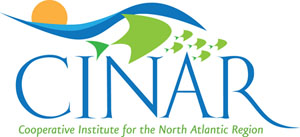New Hampshire Seacoast Region Regional ocean observing collaboration
A new tide gauge located in Hampton Harbor, New Hampshire will provide critical water level information to help emergency responders and managers, weather forecasters, coastal planners and others prepare and respond to the impacts of coastal storms and rising sea levels.
Scientists from the University of Massachusetts at Boston, center for Coastal Environmental Sensing Networks (CESN) installed a state-of-the-art tide gauge at the Hampton Fire and Rescue pier on Hampton Harbor. The tide gauge makes a measurement of water level every 6 minutes with an accuracy of 1/16th of an inch. This water level data are transmitted hourly to a remote computer and will be displayed live on the website of the Northeastern Regional Association of Coastal Ocean Observing Systems (NERACOOS) in the upcoming months. This near real-time data stream will give emergency managers critical information during coastal storm events that often lead to flooding.
“The tide gauge will help local people protect their communities in the estuary, and I’m grateful for the partnership that made this possible,” said State Senator Nancy Stiles of Hampton. Senator Stiles is working on a bipartisan bill with Senator David Watters of Dover to authorize coastal management provisions in master plans, allowing communities to take advantage of the best data available from NOAA and the State Office of Energy and Planning.

Installing tide gauge in Hampton, New Hampshire. Photo by Derek Sowers.
Hampton Fire and Rescue Chief Chris Silver said, “The town of Hampton is pleased and grateful to have this tide gauge installed here. Over the past few years we have made observations on how the higher predicted tides affect the lower coastal areas of Hampton in an effort to determine certain action levels for road closures and changes in emergency response. This tide gauge will provide us with accurate local information that will be helpful for future planning and emergency response.”
The tide gauge will also provide critical information for a coastal flooding prediction system that will be developed for the Hampton/Seabrook estuary during this year. The prediction system will forecast water levels and potential flooding in and around the towns of Hampton, Hampton Falls, and Seabrook 2-3 days into the future. These predictions will help emergency managers more effectively protect lives and property as storms approach the region. The tide gauge will also be a valuable tool for coastal planners because it will help show areas that may be permanently flooded by sea level rise in the future.
With the devastating impacts of Superstorm Sandy being estimated at $60 billion, there is heightened awareness about how much damage a major coastal storm can cause to coastal communities, and it is only a matter of time before a major storm impacts the New Hampshire Seacoast region. The tide gauge and coastal flooding prediction system will give emergency managers detailed information well in advance of an oncoming storm and help protect the lives and property of Seacoast residents.

Close up of the tide gauge that will provide water level information in Hampton, New Hampshire. Photo by Derek Sowers.
John Cannon, Marine Forecaster with the regional National Weather Service Weather Forecast Office in Gray, Maine said, “The Hampton tide gauge and the developing forecast system will greatly benefit the National Weather Service in its effort to issue timely and accurate coastal flood warnings for the Seacoast of New Hampshire. This information is crucial to emergency managers, residents and first responders in the region for the protection of life and property as was the case with hurricane Sandy.”
The installation of the new tide gauge and development of the coastal flooding prediction system is the result of a collaboration between state and federal government agencies, academic institutions, non-profit, and for-profit organizations, all committed to improving coastal storm forecasting, planning and emergency response. The cost of the gauge installation was covered by generous donation from NextEra Energy Seabrook Station to the project effort. The collaborating organizations include the towns of Hampton and Seabrook, N.H., the New Hampshire Department of Environmental Services Coastal Program, the Piscataqua Region Estuaries Partnership, NextEra Energy Seabrook Station, the National Weather Service, the Northeastern Regional Association of Coastal Ocean Observing Systems and its ocean modeling partners at the University of Massachusetts at Dartmouth and the Woods Hole Oceanographic Institution, and the University of Massachusetts at Boston, center for Coastal Environmental Sensing Networks.
To learn more about the partners in this collaboration, please visit their websites:
Town of Hampton Fire and Rescue
http://www.hamptonfirerescue.com/
National Weather Service
http://www.erh.noaa.gov/gyx/
NERACOOS (Northeastern Regional Association of Coastal Ocean Observing Systems)
http://www.neracoos.org/
Northeast Coastal Ocean Forecast System
http://www.neracoos.org/datatools/forecast/oceanforecasts
New Hampshire Department of Environmental Services Coastal Program
http://www.des.state.nh.us/organization/divisions/water/wmb/coastal/index.htm
NextEra Energy Seabrook Station
http://www.nexteraenergyresources.com/what/nuclear_seabrook.shtml
PREP (Piscataqua Region Estuaries Partnership)
http://prep.unh.edu/
UMB center for Coastal Environmental Sensing Networks (CESN)
http://www.cesn.org/



















